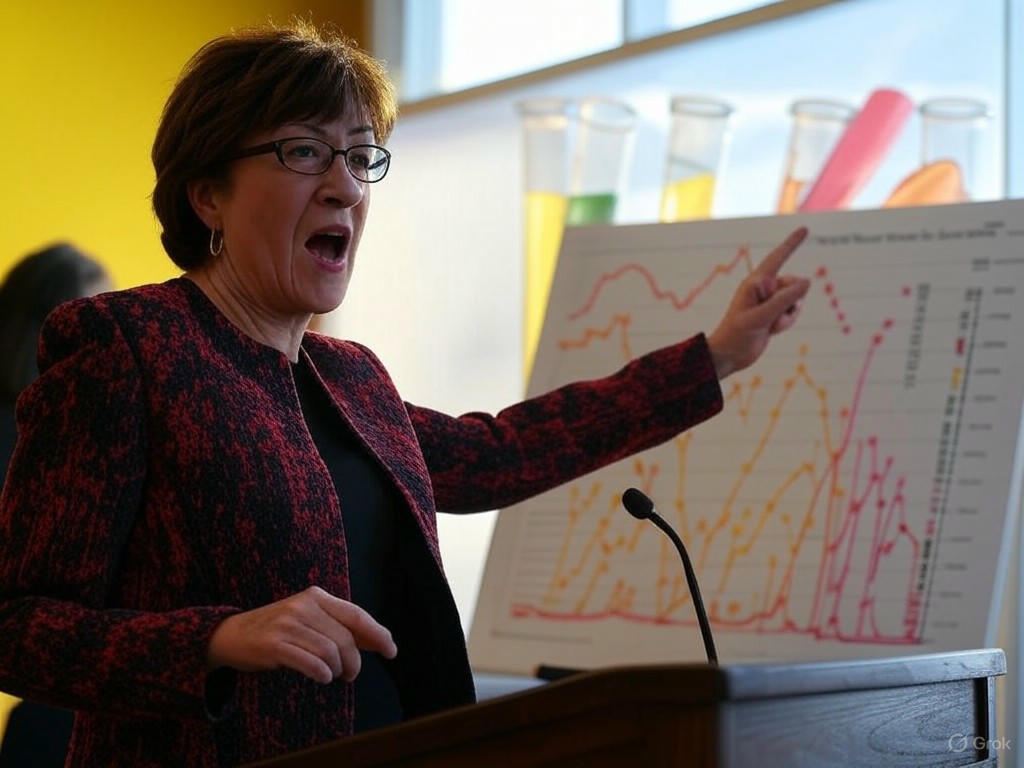
Science Funding Cuts Criticized by Senator Collins Against Trump Administration
Senator Collins Leads Bipartisan Opposition to Trump’s Aggressive Science Funding Cuts
In the midst of heated debates over federal budgets, Trump science cuts have sparked widespread alarm. Senator Susan Collins, a Republican from Maine, is at the forefront of this pushback, voicing strong concerns during a Senate Appropriations Committee hearing on April 30, 2025. Her critique highlights a proposed 44% reduction in the National Institutes of Health (NIH) budget for fiscal year 2026, a move that could undermine years of progress in biomedical research.
As the committee’s new chair, Collins didn’t hold back, calling the abrupt end to grants and layoffs of federal scientists unjustified and risky for America’s role in innovation. What’s striking is how this issue bridges political divides, drawing support from both parties and emphasizing that Trump science cuts aren’t just policy—they’re a threat to our shared future. Have you ever wondered how funding decisions in Washington impact everyday breakthroughs, like new cancer treatments?
The Scope and Scale of Trump’s Science Cuts
Trump science cuts extend far beyond mere numbers, affecting the core of American research. Reports indicate the administration aims to slash about $21 billion from the NIH budget, representing a massive blow to global biomedical efforts. This isn’t hypothetical; it’s already reshaping how scientists operate across the country.
Concrete actions include dismissing around 1,200 NIH employees in the first 100 days of Trump’s second term and rescinding over $2 billion in research grants. Other moves, like terminating contributors to climate impact assessments and pulling nearly $4 million from Princeton’s climate research, add to the disruption. While a court temporarily halted caps on indirect costs for NIH projects, the appeal keeps institutions on edge, wondering if these cuts will persist.
These steps raise questions about priorities in government spending. For instance, imagine a lab racing to develop a new diabetes therapy, only to face sudden funding halts—it’s a scenario playing out now, potentially delaying discoveries that save lives.
Impact on Medical Research and Innovation
The fallout from Trump science cuts hits medical research hard, with Senator Collins pointing out risks to trials for diseases like Alzheimer’s and various cancers. If these projects stall, effective treatments might never reach patients, stalling progress that’s taken decades to build. Hermann Haller, from Maine’s Mount Desert Island Biological Laboratory, shared how funding uncertainties are already crippling operations.
This ripple effect could erode U.S. dominance in science, allowing countries like China to surge ahead. Collins warned that such outcomes should alarm us all, as innovation drives not just health advances but economic growth too.
Economic Consequences of These Science Funding Cuts
A study from American University’s Center for Macroeconomic Analysis paints a stark picture: Trump science cuts might trigger recession-like effects on the economy. We’re talking about job losses, reduced educational resources, and a slowdown in industries reliant on research. One IT professional at Princeton described in a letter how these disruptions could lead to “deep and lasting loss,” emphasizing the high cost of interrupting momentum.
Why does this matter to you? If research grinds to a halt, it affects everything from job markets to personal health, making stable funding essential for long-term stability. Consider how a single cut could delay a breakthrough drug, impacting millions and the economy at large.
Bipartisan Concern Over Trump’s Science Cuts
What’s remarkable about Trump science cuts is the rare unity they’ve inspired across party lines. Senators from both sides have rallied against the NIH reductions, recognizing research as a non-partisan necessity. Collins stressed that the U.S. risks losing its edge if these policies continue unchecked.
She’s also highlighted threats to attracting top talent, with immigration uncertainties potentially driving young scientists abroad. “I fear we’re going to lose our brightest minds,” she said, underscoring the need for balanced policies that support innovation.
Impact on Scientific Talent and Career Development
Trump science cuts don’t just affect projects—they jeopardize careers. Young researchers face instability, which might prompt a brain drain to more supportive nations. This uncertainty chills the environment for bold ideas, where long-term commitment is key to success. How can we expect the next generation to innovate if funding feels like a gamble?
To counter this, institutions could focus on diversified funding sources, like private partnerships, to build resilience against federal shifts.
The Human Cost of Trump’s Science Funding Cuts
Behind the data are real stories, like that of a scientist whose work in Ethiopia and Kenya is now at risk due to these cuts. As Senator Cory Booker noted in a letter, such disruptions shatter job security and global efforts. Patients waiting for cures, from muscular dystrophy to diabetes, bear the brunt, as delayed research means prolonged suffering.
This human toll prompts us to ask: Is short-term saving worth the long-term loss? Collins has engaged directly with Health and Human Services Secretary Robert F. Kennedy Jr., describing his response as mixed but open, hinting at possible reversals.
The Question of Administration Priorities
Where do these Trump science cuts originate—from the secretary or higher up? Collins isn’t sure, but her dialogues suggest room for influence. This uncertainty adds another layer, urging advocates to push for clarity and change in how science is valued.
Looking Forward: The Battle Against Trump’s Science Cuts
As budget talks loom, more Trump science cuts could target agencies like the NIH and National Science Foundation. With Collins leading the charge, resistance is building, even from within her party. The fight isn’t just about money—it’s about preserving America’s innovative spirit.
Experts recommend advocating for predictable funding models to avoid these boom-and-bust cycles, ensuring research can thrive without interruptions.
The Call for Stable, Sustained Science Funding
Achieving stable funding means moving beyond reactive measures to proactive strategies, like multi-year grants that support ongoing work. This approach could shield research from political whims, fostering an environment where discoveries flourish. If you’re passionate about science, consider supporting organizations that lobby for these reforms.
Conclusion: Science at a Crossroads
Trump science cuts have put American innovation on shaky ground, with Senator Collins’ efforts shining as a beacon of hope. As Congress deliberates, the potential for reversal remains, but the urgency is clear. These decisions will shape health outcomes and global leadership for years to come, making it crucial to prioritize science over short-sighted cuts.
What’s your take on how these policies affect our future? Share your thoughts in the comments, explore more on sustainable research funding, or spread this article to raise awareness. Together, we can advocate for the progress that benefits us all.
References
- Science Magazine. “Senators from both parties criticize Trump’s moves against NIH.” Link.
- Portland Press Herald. “Collins criticizes Trump administration over scientific research cutbacks.” Link.
- RAPS. “Senator appropriators decry deep potential cuts to…” Link.
- Inside Climate News. “Sen. Susan Collins criticizes Trump for science cuts.” Link.
- Briefing Today. “Trump science cuts: Collins’ criticism.” Link.
- Rev.com. “Cory Booker historic Senate speech part 2.” Link.
- Harvard Business Review. “Ideacast feed.” Link.
- Writers and Editors. “Journalism and journalists.” Link.
Trump science cuts, Senator Susan Collins, NIH funding cuts, science research budget, biomedical innovation, federal research grants, Trump administration science policy, medical research impacts, bipartisan science support, economic effects of science cuts







